The Battle of Midway Roundtable Opening Remarks
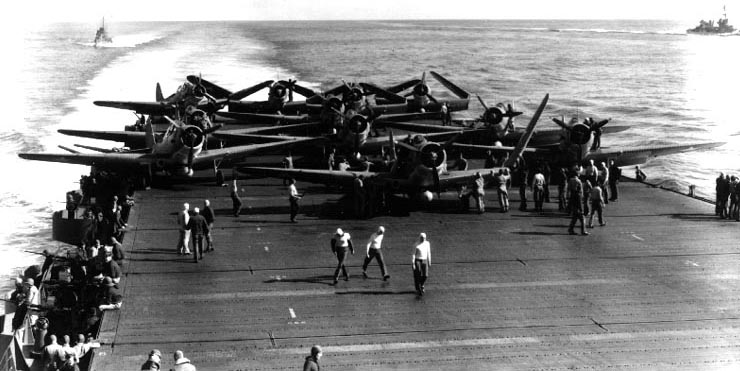
Welcome to the Battle of Midway RoundTable August edition. First I'd like to thank Ron Russell for providing the content for this month's newsletter. With my busy schedule now I very much appreciate him stepping up to the plate.
This month we have two articles that I'd like to point out, Decision at Point Luck and An Alternative to Spruance. If you don't read every article make time read these two. I think you'll find them very interesting.
Also one other article peaked my interest. The unpublished book by Wilber Roberts. I can't say I remember anything on that book specifically but somewhere in my past research I do recall writing a note referencing an unpublished account. Way back when I used to buy all kinds of books and papers on Midway. I have a copy of Nimitz's report to King for instance I purchased from one of the used books dealers as well as a number of other items. I need to dump out a bunch of very fat folders and have a look. May be something there. Years back I didn't aways get everything I ordered as mail order was the only vehicle then so I wrote down things I missed and had the book dealers do a search for me. Maybe I wrote it down. See if anything comes to light.
So on to the articles. Hope you enjoy them.
GREATEST GENERATION VETERAN STORIES
This is mainly for the WW2 vets on our roster, or their family members and other associates who can pass the word. The following message is from an enthusiastic young college student majoring in history with a particular focus on the early years of the war. If anyone reading this, veteran or otherwise, is able and willing to help the young man, please make contact, and that applies to all veterans of the era. He would really like to interview a BOM vet personally, if possible, but he’ll take whatever is offered.
The Roundtable has a long tradition of helping students of all ages, and it’s nice to see that we can still do so. I’ve already placed him in contact with the Yorktown (CV-5) Club and also with Ed Fox (BOM Marine vet). Thanks in advance to anyone who can help. Send your replies to: mnayajr@aol.com.
—RR
23 July 2021
From: Michael Naya, Jr.
I am a nineteen year old Kean University sophomore from Kenilworth, New Jersey. For nearly five years I have been interviewing Great Depression survivors, World War II and Korean War veterans. I have been doing this because I love history and one day I would like to write a book on the men and women from these events. As we approach the 80th anniversary of Pearl Harbor I have been striving to interview veterans who served at important historical events that occurred in 1942-1943, as they soon will be celebrating their milestone anniversaries. I am hoping that anybody in the Battle of Midway Roundtable might know of at least one Midway veteran to share their story in the hope that I can interview them. It is my hope to give a presentation on these events at local civic organizations such as the Rotary Club in the hope that their memories and their stories will be preserved for future generations.
I am majoring in history-education in the hope of becoming a high school history teacher. I am an honorary member of the 5th Marine Division Association, 7th Armored Division Association, the Kenilworth Rotary Club, and associate member of the American World War II Orphans Network, the Battle of the Bulge Veterans Association, the 12th Armored Division, and formerly of the Kenilworth Historical Society. I am lead and founding member of the Young Historians Program of the D-Day Squadron. The goal of the YHP is to educate children, teenagers, and young adults on the history of WWII through surviving veterans, aircraft, and educational outreach programs. I would be very grateful and appreciative of any and all help.
Thank You
—Michael Naya, Jr.
MIDWAY B-26 AIRCRAFT DESIGNATIONS
From: Bill Longton
24 June 2021
In regards to Santiago Flores' question about the B-26s on Midway launched to deliver a torpedo attack against Kido Butai [see newsletter for
May 2020
], I have found the tail number of Capt James F. Collins' plane, although the reference source escapes me at the moment. Collins' tail designation number was 40-1398, and his ship was nicknamed "Winsockie". Yes, his B-26 was a flying wreck upon its return to Midway and was bulldozed into the lagoon along with Lt James P. Muri's B-26 (tail number 40-1391). I have not found any information if they were ever pulled from the bottom or not.
In regards to Lt Muri's aircraft, I do remember that this same (unremembered) source indicated that his ship was actually nicknamed "Ole 1391" and that the name "Suzie-Q" normally attributed as what he called his ship was in fact Muri's wife Patricia's nickname that he had painted on the side for good luck. If someone can help me with that "forgotten" source, it would be appreciated. Since I know that I read it somewhere, I will stick with that nickname.
Following the battle, Muri had the section of the fuselage containing his wife's nickname cut off of the ship before it was discarded to the deep, and kept as a talisman for the rest of his life.
—Bill Longdon
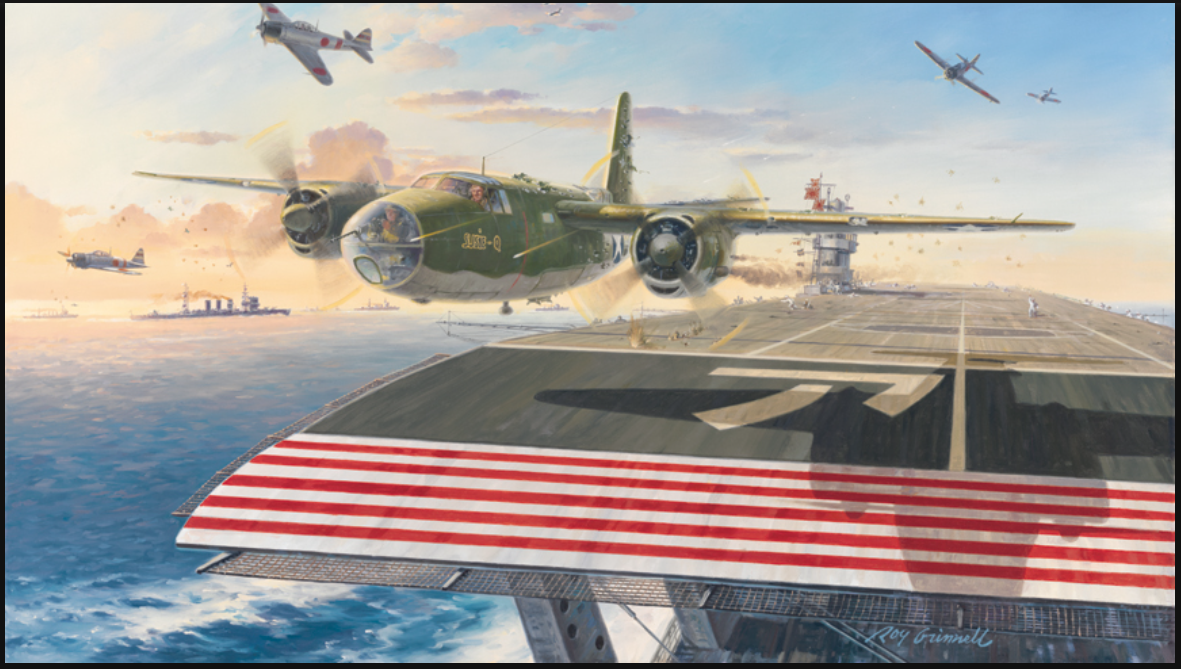
This is Roy Grinnell’s great painting of “Suzy-Q” buzzing Akagi’s flight deck, bow to fantail. See Incredible Victory, page 115.
DECISION AT POINT LUCK
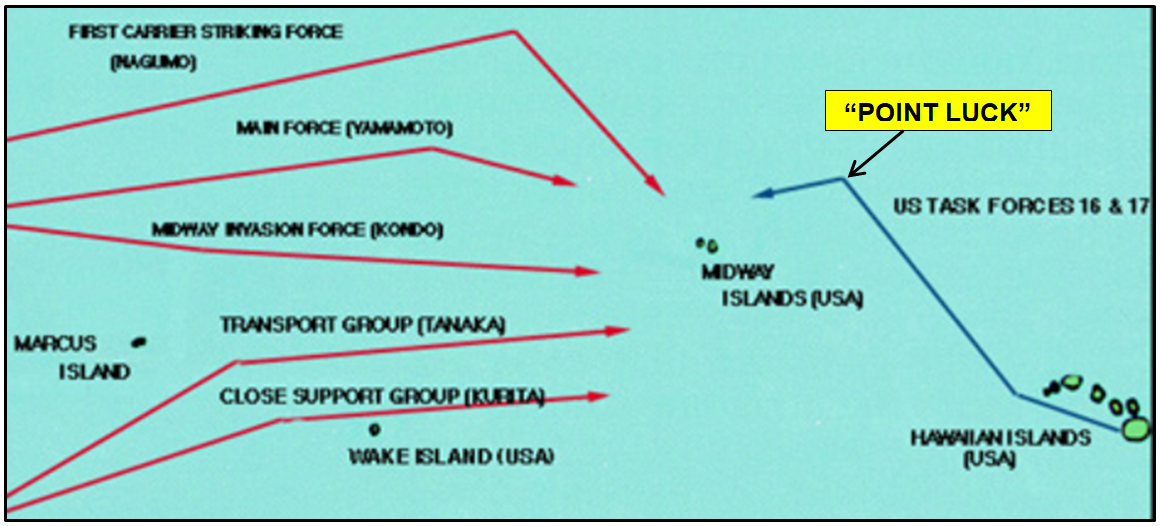
In the July newsletter, we read of Jon Parshall’s description of Point Luck as a “risk management tool” rather than an actual position from which to attack Kido Butai. Depending on the size and capability of the inbound Japanese force, Admiral Fletcher could set out on an attack course from there, or mindful of CINCPAC’s “calculated risk” admonition, wage a campaign of attrition rather than direct confrontation.
That prompted this message from Bill Longton, with a follow-up by Jon:
16 July 2021
From: Bill Longton
I have a question for Jon Parshall regarding something that he said during his webinar [for] the Pearl Harbor Aviation Museum....at what time did Admiral Fletcher make the decision to begin steaming southwest towards the estimated position of Kido Butai? Obviously, he followed Admiral Nimitz' suggestion (based upon reports in Captain Steele's "Grey Book") to move his position 180nm (+/-) further west from Point Luck, but that was on June 2. Did Admiral Fletcher wait until the PBY sighting/contact reports came in on June 4 before moving, or did he set course in anticipation of being in proper position when the reports came in during the morning?
[Ed. note: to amplify the question, when did Fletcher order his ships to proceed toward the expected enemy fleet, and what was the basis for his decision (confrontation instead of attrition) at the time? Jon replied as follows.]
19 July 2021
From: Jon Parshall
I’ve not dug into that in any depth, but Lundstrom or Symonds would probably be the place to look. Right off the top of my head, I’m pretty sure neither formation began moving towards the point of contact until after Ady’s report came in. Bear in mind that Nagumo was already two days “late,” as far as U.S. intel was concerned the opening date of the battle might be (and those estimates had changed several times during the run-up). So there was no way for Fletcher to know that June 4 was “The Day,” and I wouldn’t have supposed that he would have wanted to close until he had good spotting data. He’s not going to want to get too close, after all—if Nagumo had turned up due north of Midway, Kidō Būtai and Fletcher would already have been at a stone’s throw, which was not what Nimitz had ordered in terms of calculated risk! Prudence dictates that you don’t move aggressively until you have data in hand that lets you assess the tactical picture at least somewhat.
Indeed, John Lundstrom and Craig Symonds do have the answers in their respective books if one takes the time to connect the dots. Symonds ( The Battle of Midway, 2011) provides a preface to Nimitz’ “calculated risk” strategy with a related quote from the admiral: “Timidness won’t win this war, neither will foolish recklessness.” (Page 188). Later, Nimitz articulated that concept in detail for Fletcher in this statement:
“In carrying out the task assigned in Operation Plan 29-42 you will be governed by the principle of calculated risk which you shall interpret to mean the avoidance of exposure of your force to attack by superior enemy forces without good prospect of inflicting, as a result of such exposure, greater damage to the enemy. This applies to a landing phase as well as during preliminary air attacks.”
He reinforced it further by telling Fletcher not to “accept such decisive action as would be likely to incur heavy losses in our carriers and cruisers.” (Symonds, p. 195.) Thus Fletcher had to be ready for two scenarios; one being the aggressive implementation of Op-Plan 29-42 providing the risk didn’t seem too great, and if it did, then a “plan B” for whittling down the enemy while avoiding capital ship losses. Which course he’d follow would be decided at Point Luck.
The “why and when” for the ultimate decision can be found in numerous references, and Lundstrom’s Black Shoe Carrier Admiral (2006) is one of the better choices. First, the key question is, what did Fletcher know, and when? His CTF-17 staff radiomen (including our own Dick Brown) had copied a transmission from Midway that included Ady’s “two carriers” sighting and had it in Fletcher’s hand only 11 minutes after it was sent from the PBY. He did not hesitate; immediately ordering TF-16 to commence its attack per the op-plan. The timing goes like this:
0552: Ady’s “two carriers” message.
0603: Fletcher learns that two carriers have been found.
0607: Fletcher orders Spruance to attack.
So to answer Bill Longton’s first question, the decision at Point Luck happened on June 4th at 0603, and it was executed four minutes later, initially by TF-16. There probably never was a lot of planning on a “gradual attrition” strategy as suggested above, since Fletcher was pretty much bound by Op Pan 29-42; it was simply up to him to get it done while trying really hard to avoid undue risk.
But was there anything to fully dispel any notion of a “plan B?” Of course there was, and it was caused by a few clouds over Kido Butai. Ady only saw two carriers, even though all four were there. That looked a lot like CINCPAC’s prediction of separate carrier task groups. Two enemy carriers steaming in company was an obvious target and exactly what had been expected. There would be no plan B—no campaign of attrition. The Battle of Midway would be nose to nose.
If you’d like to look up the references, start with Black Shoe Carrier Admiral on page 241, in addition to the citations in Symonds’ book above. The timeline in Miracle at Midway also helps: see page 440.
Many thanks to Bill Longton for initiating this topic, and to Jon Parshall for giving us more to think about with regard to Point Luck.
—RR
AN ALTERNATIVE TO SPRUANCE?
In July, Brian Anderson sent us an interesting two-part question:
"What obligation was Nimitz under to follow Halsey's recommendation as to who replaced him in command of TF-16? And who was an alternative to Spruance?"
Of course, the first answer was easy: none. Nimitz was the fleet commander, so it was clearly his call. But any good commander considers the counsel of his subordinates, and Halsey’s endorsement was probably enough.
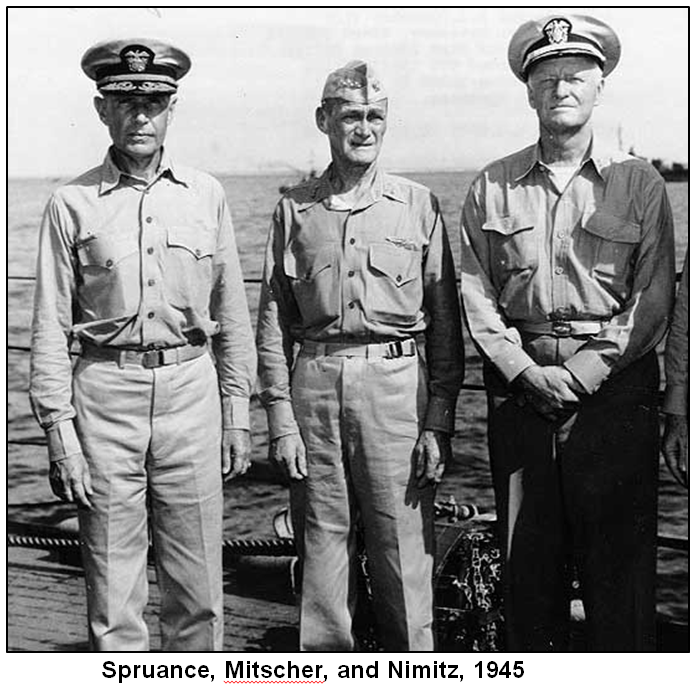
But Brian’s second question got me to thinking. Midway (1976) has Halsey (Robert Mitchum) emphatically and instantly saying “Spruance!” when Nimitz asked him for his recommendation. Incredible Victory describes it the same way in more detail (p. 30). Was the decision that quick and definite? Or, was there some back-and-forth among the CINCPAC staff, especially the air officers, over placing yet another blackshoe in charge of a carrier task force? Who among them, or anyone, could’ve been a viable alternative? Incredible Victory mentions “several other possibilities” without naming them. So who were they?
Mitscher can be eliminated immediately: although a rear admiral selectee, he would’ve been junior to Spruance within TF-16, and the Navy didn’t do that sort of thing among its flag ranks (which may have been fortunate as it turned out). The only other admirals in the fleet at that time with carrier combat experience were Halsey and Fletcher. Halsey was out, and Fletcher had TF-17—moving him to TF-16 would’ve simply created a leadership void on the Yorktown, with no good options for filling it.
Actually, in that early era there was an acute shortage of admirals who were also aviators. Naval aviation was so new that very few of the junior officers who pioneered it had accrued sufficient time in grade to rise to flag rank, which had been the basic reason for Fletcher’s selection as a carrier commander, and ultimately Spruance’s. For command of TF-16, the lack of pilot wings became secondary to intimate familiarity with the ships and personnel of the task force plus the trust of both Halsey and Nimitz, who had already selected Spruance to be the new CINCPAC chief of staff. All of that pretty much canceled any thought of an alternative for CTF-16. Spruance was a lock.
Still, it might be instructive to review Walter Lord’s “several other possibilities” and consider how the BOM would then have played out with one of them in charge on the Enterprise.
—RR
UNPUBLISHED BOM MANUSCRIPT BY VB-6 PILOT
We received a request from David Rigby, author of Wade McClusky and the Battle of Midway (Osprey Publishing, 2019), for information or even a copy of a rare unpublished manuscript said to have been written by BOM VB-6 pilot Wilbur Roberts (LTjg in 6-B-5 at Midway). The title of the work may be Many Planes Heading Midway, but that’s not definite.
Mark Horan says he’s aware of a writing by Roberts of uncertain title or content but finding and reproducing it may be a tall order. However, such works tend to get distributed among several people, as with our unpublished veteran accounts by Tom Cheek and others in No Right to Win. So the question is, does anyone else have anything that looks like it might be what David is seeking—any sort of document written by BOM vet Roberts? If you do, please let us know and we’ll work out some way to get it reviewed and possibly made available.
4 JUNE 1942: WHAT, WHERE, AND WHEN
Over the years we’ve seen a great many maps and charts that display the BOM’s events in graphic form, either the entire battle or some element of it. In seeking appropriate images on the Internet to include in our various Roundtable articles, it’s very normal for me to pull up any number of them of varying clarity, accuracy, vintage, and familiarity; most of which evoke only passing interest. But while working on an article for last month’s newsletter, I was abruptly stopped by this one:
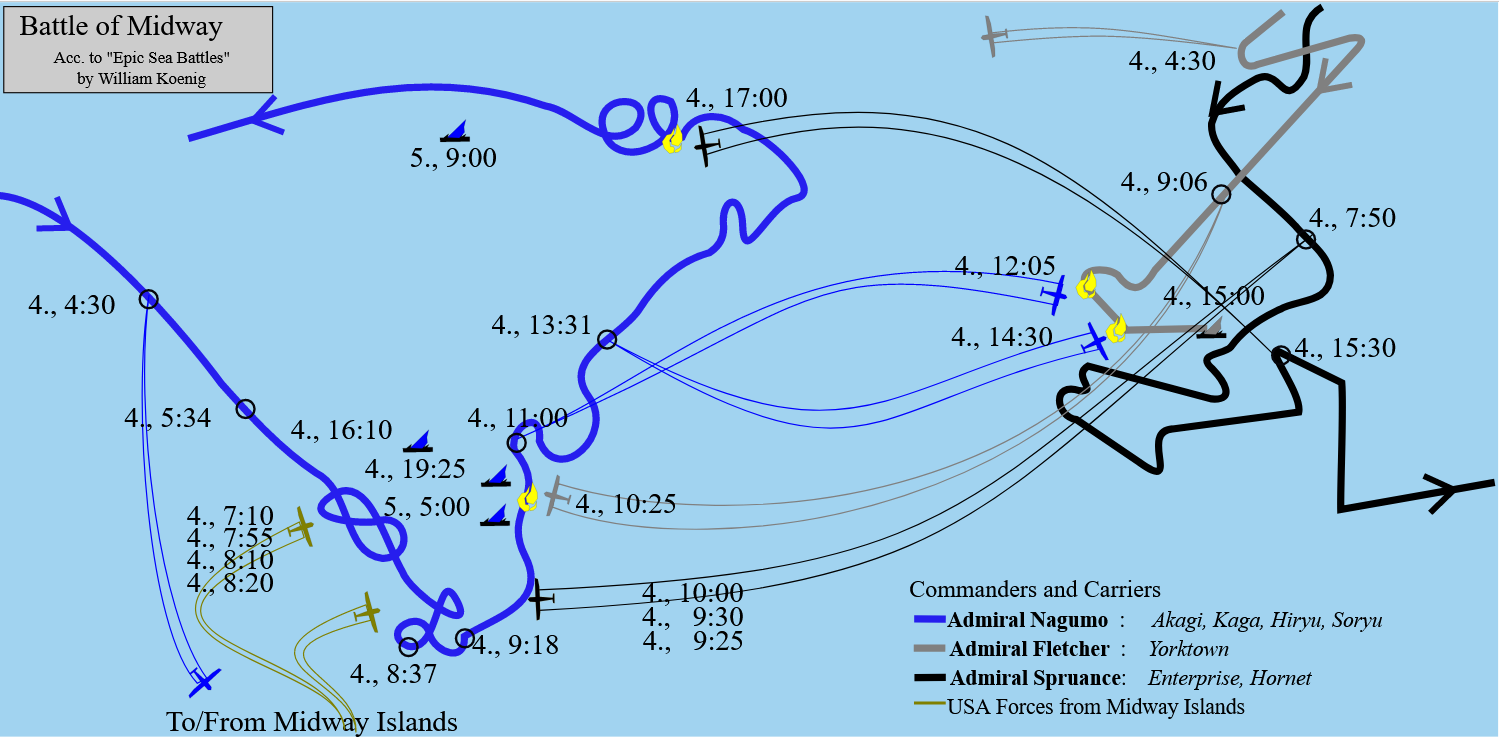
There are a lot of Midway images that show the tracks of the various fleets, or the courses of the various air strikes, or occasionally even both. But this one shows all of that plus unique color coding for each fleet and air group, the position of each carrier upon launching a strike, the location of each specific strike against opposing ships, the location where each of the five carriers was put out of action or sank, and the time that all of those events happened, all in one unusually clear and concise picture.
The color coding is especially helpful. There’s a guide at the lower right, but to clarify it even more:
BLACK: TF-16 (Enterprise, Hornet & their aircraft)
GRAY: TF-17 (Yorktown & aircraft)
OLIVE: Midway air group (AAF, Marines, TBFs)
BLUE: Kido Butai & aircraft
While the diagram is very interesting for its wealth of information, it doesn’t show everything. You need to be well-versed on the battle’s details to know what’s happening at each posted time, i.e. “4, 4:30” at the upper right with no further explanation—that’s the 0430 launch of the VS-5 search from Yorktown. The same time at the far left shows the launch of the Midway strike by Kido Butai. The timeline starting on page 440 in Miracle at Midway may help if you need it.
Credit for this remarkable image goes to author William Koenig, as indicated in the upper left corner. His book Epic Sea Battles is said to include a large number of maps like this one, and you can find it with an Internet search if interested. —RR
DEVASTATORS IN THE BATTLE OF MIDWAY
Back in June, Tom Rychlik sent us a couple of interesting Youtube links on the subject of the TBD Devastator:
#1.
https://www.youtube.com/watch?app=desktop&v=cVLgZquFTrc
That one is “Perilous Mission: Devastators in the Battle of Midway.” It’s a rudimentary account of BOM air-sea combat, with a primary focus on the Devastator. There are a lot of TBD images, but as you might guess, several of them are clearly not Midway-authentic. Some have markings that place them in unrelated squadrons, different timeframes, or both. But have a look anyway, as there’s a good collection of interesting TBD photos that may be new to you as they were to me, like this example:
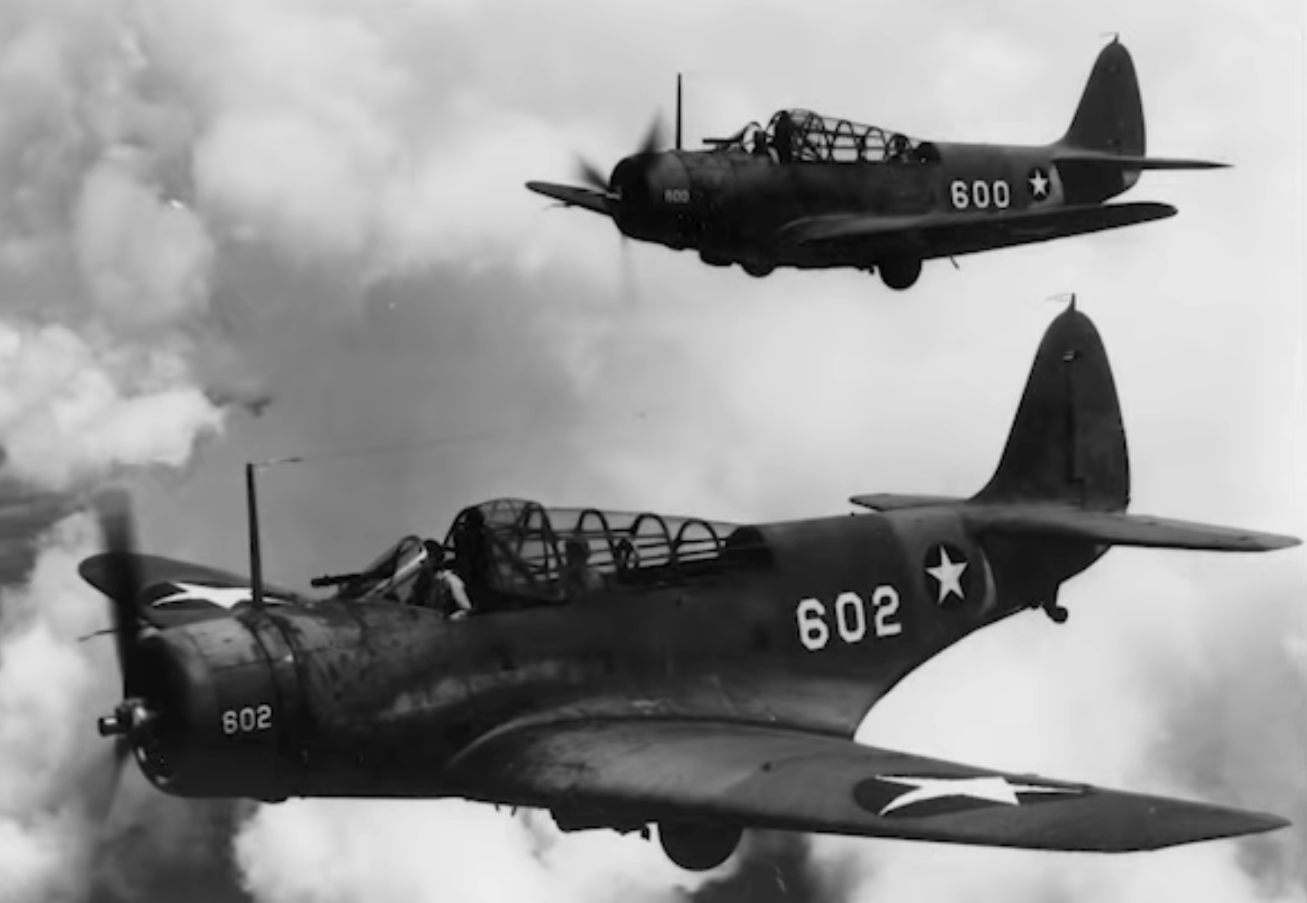
Incidentally, notice in this photo that “602” has an aircrewman in the bombardier’s seat behind the pilot, while in “600” that seat is empty but the radioman-gunner’s seat at the rear is occupied. Makes you wonder what they’re doing; perhaps a demonstration flight. At least the time period matches the BOM era, as evidenced by the roundels, May ’42 through June ‘43. Can anyone tell us the squadron or operating area for these planes?
#2.
https://www.youtube.com/watch?v=8Q7RpyUJB10
This one is entitled “In Defence of the Worst Aircraft of World War II—TBD Devastator,” and it’s quite a bit more interesting. It’s a very good rendition of the entire TBD story, from the earliest torpedo bomber biplanes in the 1920s to the vastly improved TBD in 1935 (vastly improved over what it replaced, that is). This is another in a series from the Military Aviation History Youtube channel—we featured their excellent episode on “The Flight to Nowhere” in our June newsletter. The narrator, Christoph Berg, does very well, and he’s a lot kinder on the TBD than the title suggests, pointing out the plane’s major advances over the cloth-winged biplanes that it superseded.
In summary, this may be the best overview of the TBD available on video. The run time is 33 minutes, and I can recommend it, with thanks to Tom Rychlik for the suggestion.
(Side note: in case you didn’t know the precise time frame for the aircraft roundels shown in the above photo, check out the handy guide on our website: on the home page, click “The RoundTable” on the top toolbar, then “Special Features,” and finally Link #4. You’ll then start catching a whole lot of allegedly authentic World War II aircraft photos that are clearly from the wrong year, the wrong region, or both.)
—RR
MIDWAY 2019 – ROUND 3
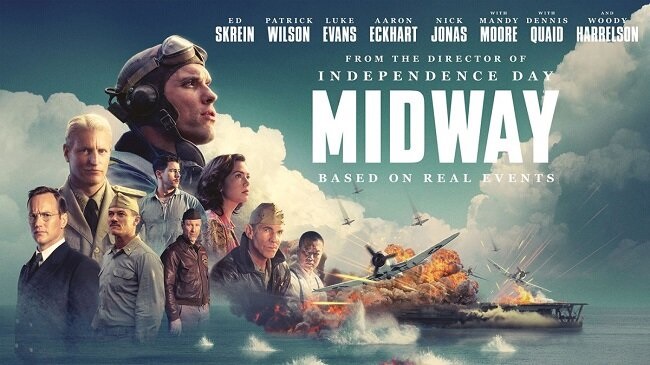
By now it’s likely that nearly all of our members and readers have digested about as much of Midway (2019) that they want and have moved on. While providing some impressive BOM imagery, the script left much to be desired despite coaching by the Roundtable’s Thom Walla and others who tried hard for a realistic result.
The film was extensively reviewed in the December 2019 and February 2020 issues of our newsletter. Since those reviews were mostly negative, I took a second look in March 2020 in order to seek out the positives, those things that producer Roland Emmerich & company got right. I’d done that previously for the 1976 film, finding a decent collection of good points in that much-maligned earlier work. Unfortunately, Midway-19 didn’t measure up to Midway-76’s score on the plus side. Aside from the VB-6 attack on Akagi and the performance of a select few actors, there wasn’t much to celebrate.
Still, since Midway-19 is the current signature movie on the battle, it will continue to evoke high interest by anyone with a BOM focus. With that in mind, a few idle hours in June prompted me to give the film a third look to see what I may have missed during the first two viewings.
Things didn’t go well at the outset. We’re told that Midway is “based on real events,” but more correctly, it’s based on real people, and it has those “real” people doing and saying things that they never did nor said. Next we’re told that Midway was the “most important naval battle in American history.” Sounds fine, unless you actually know American history—the most important naval battle in American history occurred in 1781 when the French defeated a Royal Navy fleet in Chesapeake Bay, directly bringing about the British surrender at Yorktown and American success in the Revolutionary War. Without that improbable French win over a foe that almost always bested them, the Brits fare far better and the U.S. far worse, possibly ceasing to exist. So yes, Midway was hugely important to all world history that followed it, but another unlikely naval victory in America’s past made it possible.
So much for the movie’s first minute! What else is worthy of note? No matter where your attention is drawn in the next hour and a half, it’s really hard to ignore the abysmal characterization of some of the battle’s key personnel, starting of course with Best. But he’s not the only one—those who had known Joseph Rochefort in person were aghast at his ridiculous portrayal by Hal Holbrook in Midway-76. Surely, any remake would fix that travesty, right? Not quite. While Brennan Brown’s Rochefort in Midway-19 wasn’t quite the farce displayed by Holbrook, it was still very wrong, as detailed in our December 2019 newsletter by Elliot Carlson, author of Joe Rochefort’s War. The Hypo commander wasn’t a meek introvert, he didn’t hide out in a private office, and he certainly was never unkempt and disheveled in the presence of Nimitz.
It’s really too bad that Emmerich didn’t take a clue from other historical dramas in which a very intense character is needed to arouse interest: make up a fictional personality who does and says what you want—the general audience won’t know the difference and reviewers won’t one-star your film into oblivion. For example, consider Lt. “Warren Henry” in The Winds of War: a fictional composite of several Enterprise pilots: very well done, no pretenses about being an actual historical character, and Winds of War is five-star all the way. Had “Dick Best” in Midway-19 been replaced by a fictional pilot like Barrett Tillman’s Ensign “Buck” Rogers (in Dauntless, Bantam Books, 1992), the movie’s credibility would have been far better—an interesting irony.
Finally, the film ends with a dedication to both the American and Japanese personnel who lost their lives at Midway. Okay, I get it why Emmerich had to include the Japanese in his dedication, but I’m sorry, that simply does not work for me. Certainly, the majority of the IJN sailors and airmen in the battle were simply doing what they’d been trained and ordered to do—that’s fine. But when I think of them at Midway, I can’t ignore the Zero pilots who, in a total absence of military necessity, murdered defenseless Marine pilots in their parachutes and life rafts, nor the equally brutal murderers of Osmus, O’Flaherty, and Gaido aboard IJN destroyers. I know we’re supposed to let those things go at this very late date, but I don’t. For me, the movie’s closing dedication is an insult to every American KIA at Midway.
So what did I learn from Round 3 of Midway-19? Unlike my experience with Midway-76, there really isn’t much else to discover through multiple viewings of this thing. The characterizations of Best and Rochefort are still awful, those of Nimitz and Layton are still excellent, there’s still too much irrelevant footage (Pearl Harbor, China, the Marshall/Gilbert raids), and the incomprehensible omissions are still missing, like the Hornet, the Yorktown, and Admiral Fletcher!
(Okay, we did see the Hornet on the Doolittle mission, and we saw Nimitz touring the Yorktown in drydock. As I recall, though, those ships were also at the Battle of Midway!)
In the end, I’m glad that I did buy the DVD—the special features covering the movie’s hardware and the actor’s impressions and feelings about the roles they were playing are really quite interesting and well done. If I ever want to do a Round 4 with Midway-19, I’ll probably stick to those.
—RR
TO OUR MEMBERS AND READERS: THANK YOU
Keeping the BOMRT going requires managing a website and editing its content, but none of that would matter without the active participation of you members and others who read the articles and send us your inquiries and comments. The Roundtable started in the last century as a collection of contributors’ email messages, and today we are still very dependent on that same basic ingredient, 24 years later.
So keep them coming, and here’s a thank you to everyone who has sent in questions or information since we got the new website online in June. Without your input, this would be a very unrewarding task.
|